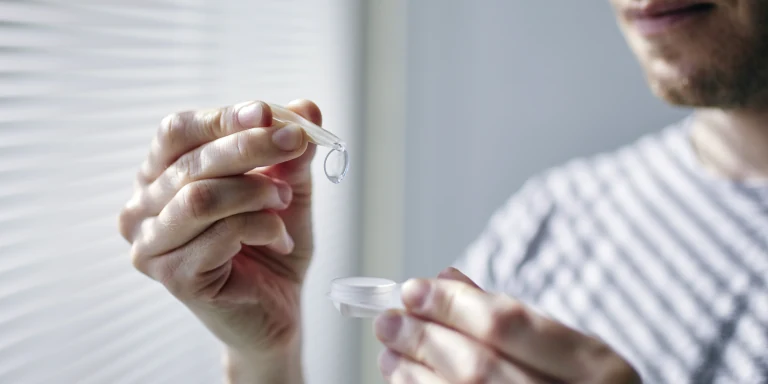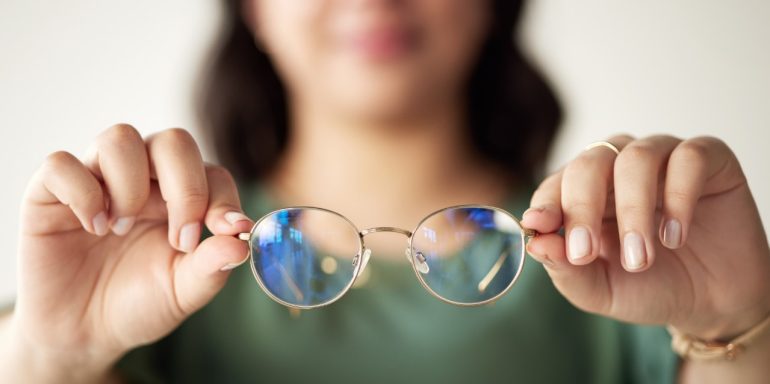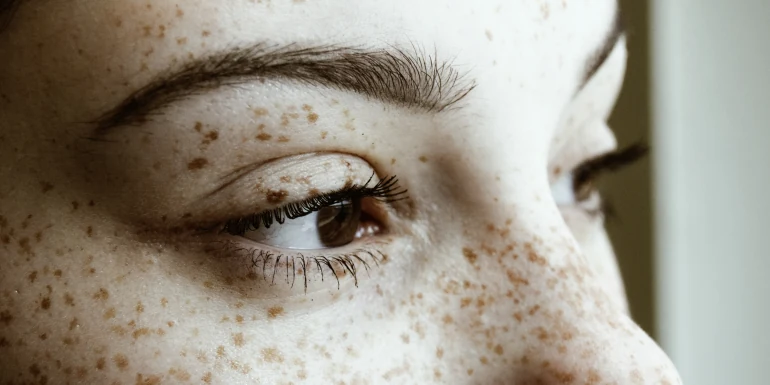Glasses vs contact lenses: which is better?
Visual aids help us see clearly despite poor eyesight. But which is more suitable for doing so: a pair of glasses or contact lenses? Learn more about the pros and cons of each variant and Helsana’s contribution towards their costs.

Four out of five people in Switzerland need a visual aid, according to a survey by the Optikschweiz association. Out of the entire population, 55.2% wear glasses, while 22.2% switch between glasses and contact lenses. Just 2.7% wear contacts 100% of the time.
Glasses vs contact lenses: which is more suitable for me?
Pros of glasses
- You can put glasses on and take them off at any time.
- Even if you have hay fever or a cold, you can still wear them with no problems.
- Glasses protect your eyes from dust and exposure to wind.
- Because glasses don’t have direct contact with your eyes, they don’t stress them.
- You don’t need to purchase expensive care products.
Cons of glasses
- You cannot wear them for certain athletic activities, such as swimming or contact sports.
- When it’s very sunny outside, you will also need prescription sunglasses.
- The lenses can fog up and have reduced visibility in the rain.
- Glasses are fragile and must be protected against damage.
- Stronger correction lenses are very thick and can feel bulky.
Pros of contact lenses
- There’s no danger in wearing contact lenses for athletic activities.
- The lenses do not slip out of place or fog up.
- They don’t leave pressure marks and do not limit your field of vision.
- Contact lenses can be worn with regular sunglasses, meaning you do not have to purchase prescription sunglasses.
- Contacts don’t affect your appearance, unlike a pair of glasses.
Cons of contact lenses
- No matter which type you use, you must regularly purchase additional lenses and care products.
- Contact lenses are less suitable if you suffer from hay fever: they can add to your eye irritation.
- Exceeding the maximum recommended wearing time can lead to eye inflammation.
- Properly handling contact lenses takes practice. At the start, putting them in and taking them out is somewhat cumbersome, although you quickly learn the correct technique.
- Pathogens may get into the eye when you put in contacts, potentially causing contact lens keratitis.
Conclusion
Glasses and contact lenses both have pros and cons. The one that suits you better depends on your preferences and needs. Maybe you’d also be happy having both options. That way, you can wear contact lenses when exercising and glasses while at work.
What we contribute to your visual aid
With COMPLETA supplementary insurance, you receive 90% of the costs of spectacle lenses and contact lenses, up to CHF 300 per calendar year. Supplement your COMPLETA insurance cover with COMPLETA PLUS and also receive 90% of the costs, up to a maximum of CHF 200 per calendar year, for spectacle lenses, frames and contact lenses.
What types of contact lenses are there?
There are all kinds of contact lenses. They differ based on their use, material and wearing time. Here’s an overview of the different types:
Spherical contact lenses
Spherical contact lenses correct short- or long-sightedness. They are rotationally symmetric, which means they have the same shape all around.
Scleral contact lenses
Scleral contact lenses compensate for astigmatism, so they are individually tailored to fit on the ocular surface.
Bifocal and multifocal contact lenses
Bifocal and multifocal contact lenses combine several correction strengths on a single lens with different areas used to see near and far. They are used to treat age-related long sight, which is when your close visual acuity declines.
Hard contact lenses
Hard contact lenses are made of rigid, gas-permeable plastic. They are custom-made and do not cover the entire cornea. In addition, they do not adhere tightly to the eye. Instead, they move loosely in the tear film that covers the eye. This allows the cornea to be cleaned with fresh tear fluid when you blink.
Hard contact lenses are yearly lenses, which you can wear for a whole year or more.
Soft contact lenses
Soft contact lenses are made from a flexible material. They hug the cornea and cover it completely, which keeps them firmly in your eye. Hydrogel contact lenses have a high water content. The more water in them, the greater the amount of oxygen that reaches the eye. Because the fluid film does evaporate quickly, however, these lenses are less suitable for dry eyes and long wearing times. Silicone hydrogel contact lenses contain gas-permeable silicone, So, although their water content is significantly lower, they maintain an adequate supply of oxygen to the eye. They can be worn for extended periods and are also suitable for dry eyes.
Soft contact lenses are available as daily, weekly, monthly and yearly lenses.
Daily contact lenses
You wear daily lenses for just one day before switching to a new pair. If you only wear contact lenses occasionally, these are a good fit.
Monthly contact lenses
You wear monthly contact lenses for 30 days in a row before replacing them with a new pair. You should keep to this schedule, even if you didn’t wear your contacts on specific days. Even though you clean the lenses daily, bacteria and other residue still build up over time. Monthly contact lenses are suitable if you wear contact lenses on most days.
Yearly contact lenses
You only change yearly lenses after one year of use. They are made to be worn every day and are often more robust than daily or monthly contact lenses. Proper care is very important for annual contact lenses because this maintains their comfort and clarity. Yearly lenses are suitable if your visual acuity generally stays constant and you wear contact lenses on most days.
Coloured contact lenses let you change or intensify your eye colour. They are available with or without a prescription. Depending on the material and type of print, they let more or less oxygen through, which thus changes the maximum recommended wearing time.
Articles about this topic
Do you have questions?
We're here to help.


